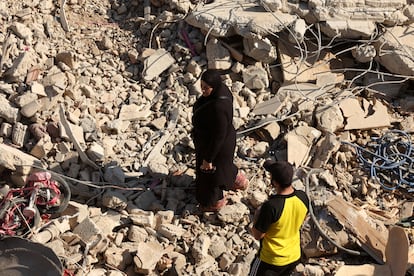Israel bogged down in southern Lebanon: ‘50,000 soldiers have not been able to conquer a single village’
A weakened Hezbollah continues to fight in the area near the border despite severe blows against its leadership and operational structure


From the terrace of Ali’s brother’s house in Meiss Ej Jabal, the plains of Galilee in Israel could be seen. This Lebanese Shia, who asks to remain anonymous, was born next to the unofficial border that Israeli troops crossed on October 1, when they launched their ground offensive in Lebanon 18 years after the last time their Lebanese enemy, Hezbollah, forced them to retreat after a brief and disastrous 34-day war. In Beirut, Ali, who is about 70 years old, shows photos of the house, a beautiful building nestled in land crisscrossed by olive trees and vineyards. None of it exists anymore: another satellite photo of the property shows a wasteland. The Israeli army, he says, blew it up.
Ali’s village is now empty. Its inhabitants have fled, like those of the other villages near the border, a three-kilometer strip that Israeli Defence Minister Yoav Gallant has dubbed “the first belt” of the southern offensive against the Shia party-militia. In that area, massive bombardments, the expulsion of the population, and the contamination of fields with white phosphorus — as denounced by Amnesty International — point to a scorched-earth strategy. Its aim, Ali believes, is to make “the region uninhabitable.” Hezbollah would thus be deprived of what Israel considers to be its social base in the region: the Shia community that lives along the border between the two countries.
The Israeli army has not, however, gained a foothold in the land it is ravaging, according to videos its own soldiers have posted on social media, such as one released on Monday showing the blowing up of numerous buildings in Meiss Ej Jabal. “The soldiers go in, blow up the houses, and return to Israel at night, because that is when the militants [Hezbollah] attack them,” Ali said. An Israeli newspaper, Yedioth Ahronot, criticized on Friday that, in the month since the ground offensive began, “50,000 soldiers have not been able to conquer a single village in Lebanon.”
The article referred to the troops from the five divisions deployed in northern Israel for the invasion of Lebanon. They are not just any soldiers: the first Israeli forces to enter the Arab country were part of the elite units of the 91st Galilee Division, the Golani Reconnaissance Brigade, and the Egoz commandos, created in 1995 specifically to fight Hezbollah. The furthest these soldiers have penetrated, says Ali, is “a few kilometers.” All this, despite facing a militia that is very weakened after the setbacks that Israel managed to inflict on it in September.
A video circulated on Monday showing the rigging and detonation of several homes in the southern town of #MaysAlJabal, specifically the buildings located a few meters away from the Mays al-Jabal Government Hospital. The footage shows between 10 and 20 targeted explosions,… pic.twitter.com/pfiO2NVtqk
— Megaphone News English (@MegaphoneNewsEN) November 4, 2024
In the 11 days of September between the detonation of thousands of pagers and walkie-talkies and the assassination in Beirut of its secretary general, Hassan Nasrallah, the movement that emerged in 1982 to fight the Israeli occupation suffered unprecedented defeats. Israel was already covering Lebanon with bombs. In one day alone, September 23, 600 people died in these attacks. On that day alone, Israel claimed to have hit 1,600 Hezbollah military targets. Although “seriously degraded” — according to a military analyst and retired Lebanese general who is very critical of the paramilitary group, Khalil Helou — Hezbollah still “resists, ambushing Israeli troops, planting explosives, and using projectiles that have even reached the southern region of Tel Aviv.”
In the first four weeks of the Israeli ground operation, Hezbollah has been involved in “more than 50 armed clashes” with Israeli troops, according to data from the NGO ACLED. This conflict monitoring organization has recorded another 60 actions by the militants such as “the detonation of improvised explosive devices or the launching of rockets, anti-tank missiles, or mortars against Israeli forces.” October was the deadliest month for the Israeli army this year, with 62 soldiers killed in Gaza and Lebanon. In large part, this was due to the war against Hezbollah: 37 of these died on Lebanese territory.
Last Friday, the day before Israel announced the figures, Hezbollah had raised Israeli casualties to 95 and claimed to have destroyed 42 Merkava tanks, among other Israeli equipment — figures that are impossible to verify. “Both sides tend to exaggerate their achievements,” Andreas Krieg, a defence expert at King’s College London, told Middle East Eye in mid-October. However, Israel’s lack of territorial advances suggests, in his opinion, that the Israeli military has encountered “fiercer resistance than they had expected.”
“Hezbollah retains good reconnaissance capabilities [...] and has staged several ambushes against Israeli soldiers using improvised explosive devices and close-quarter small-arms fire,” said a document on October 22 issued by the Atlantic Council, a think tank with close ties to NATO, the United States, and the United Kingdom, all allies of Israel.
Air superiority
Israel is betting, at least for the moment, on prioritizing its unbeatable air superiority rather than expanding a ground offensive that it has described from the outset as “limited.” In September and October, the number of bombings in Lebanon “far exceeded” the attacks in Gaza “in any month last year,” according to ACLED, although with far fewer deaths than in the Palestinian strip, due to the tiny size of the enclave, its high population density, and the impossibility of Gazans fleeing.
Since October 8, 2023, when Hezbollah began attacking northern Israel with rockets in response to the Gaza offensive, more than 3,000 Lebanese have been killed, according to official figures. Of these, retired General Hisham Jaber, who was commander of the Beirut military region, says in his Beirut office, “80% were civilians.” General Helou, for his part, estimates the number of Hezbollah fighters killed at “1,000.”
Israel’s attacks on Hezbollah have not prevented the party-militia from continuing to launch missiles and drones, in strikes that have even increased “their scale and geographic reach” in Israeli territory, ACLED confirms. On October 20, a drone hit the home of Israeli Prime Minister Benjamin Netanyahu in Caesarea, north of Tel Aviv. Six days earlier, another unmanned aircraft killed four Israeli soldiers and wounded more than 60 in Binyamina, south of Haifa, about 65 kilometers (40 miles) from the border with Lebanon. One of the declared objectives of the war — the return of the 60,000 Israelis displaced from the north of the country by Hezbollah rockets — thus seems just as implausible as it was months ago.
Since the first Israeli invasion of Lebanon in 1978, Israel has launched ground offensives on three occasions: in 1982, 2006 and 2024. These offensives, also described as “limited and localized,” preceded much more ambitious ground invasions in the past, something that has not yet happened. In 1982, only a week had passed since the entry of Israeli troops into Lebanon, on June 6, when soldiers began to advance towards Beirut. At that time, the target was the Palestine Liberation Organization (PLO), which Israel managed to expel from the Arab country. However, that brutal invasion led to the rise of Hezbollah: 18 years later, in 2000, the paramilitary organization forced Israel to withdraw from Lebanon. Six years later, in 2006, the now party-militia caused a new Israeli withdrawal, which ultimately ended up reinforcing Hezbollah’s power.
Faced with the powerful Israeli army, then as now, Hezbollah's strategy is based, explains General Jaber, on "guerrilla warfare" and an "excellent knowledge of the terrain." These militants have been trained to attack Israeli soldiers autonomously, without receiving orders from their commanders, noted a report by the Center for Strategic and International Studies in March. This could explain why, with the group's chain of command damaged and many of its leaders killed, these militants continue to fight in southern Lebanon.
Sign up for our weekly newsletter to get more English-language news coverage from EL PAÍS USA Edition
Tu suscripción se está usando en otro dispositivo
¿Quieres añadir otro usuario a tu suscripción?
Si continúas leyendo en este dispositivo, no se podrá leer en el otro.
FlechaTu suscripción se está usando en otro dispositivo y solo puedes acceder a EL PAÍS desde un dispositivo a la vez.
Si quieres compartir tu cuenta, cambia tu suscripción a la modalidad Premium, así podrás añadir otro usuario. Cada uno accederá con su propia cuenta de email, lo que os permitirá personalizar vuestra experiencia en EL PAÍS.
¿Tienes una suscripción de empresa? Accede aquí para contratar más cuentas.
En el caso de no saber quién está usando tu cuenta, te recomendamos cambiar tu contraseña aquí.
Si decides continuar compartiendo tu cuenta, este mensaje se mostrará en tu dispositivo y en el de la otra persona que está usando tu cuenta de forma indefinida, afectando a tu experiencia de lectura. Puedes consultar aquí los términos y condiciones de la suscripción digital.
More information
Archived In
Últimas noticias
Most viewed
- David King, chemist: ‘There are scientists studying how to cool the planet; nobody should stop these experiments from happening’
- Reinhard Genzel, Nobel laureate in physics: ‘One-minute videos will never give you the truth’
- Mexico completes its trade shift with the entry into force of tariffs on China and countries without trade agreements
- Oona Chaplin: ‘I told James Cameron that I was living in a treehouse and starting a permaculture project with a friend’
- Sinaloa Cartel war is taking its toll on Los Chapitos








































